Competitive Strategy Report: Analysis of Woolworths, Coles, and ALDI
VerifiedAdded on 2022/10/01
|8
|2102
|461
Report
AI Summary
This report provides a comprehensive analysis of competitive strategies, focusing on SWOT, PESTEL, and Porter's Five Forces. The report applies these models to real-world business examples, including Woolworths, Coles, and ALDI supermarkets. The SWOT analysis examines the internal strengths and weaknesses and external opportunities and threats faced by Woolworths. The PESTEL analysis delves into the macro-environmental factors affecting Coles Supermarket, including political, economic, social, technological, environmental, and legal aspects. Finally, Porter's five forces framework is used to assess the competitive dynamics within the supermarket industry, with a specific focus on ALDI. The report concludes by highlighting the importance of these competitive strategies in understanding market dynamics and making informed business decisions.
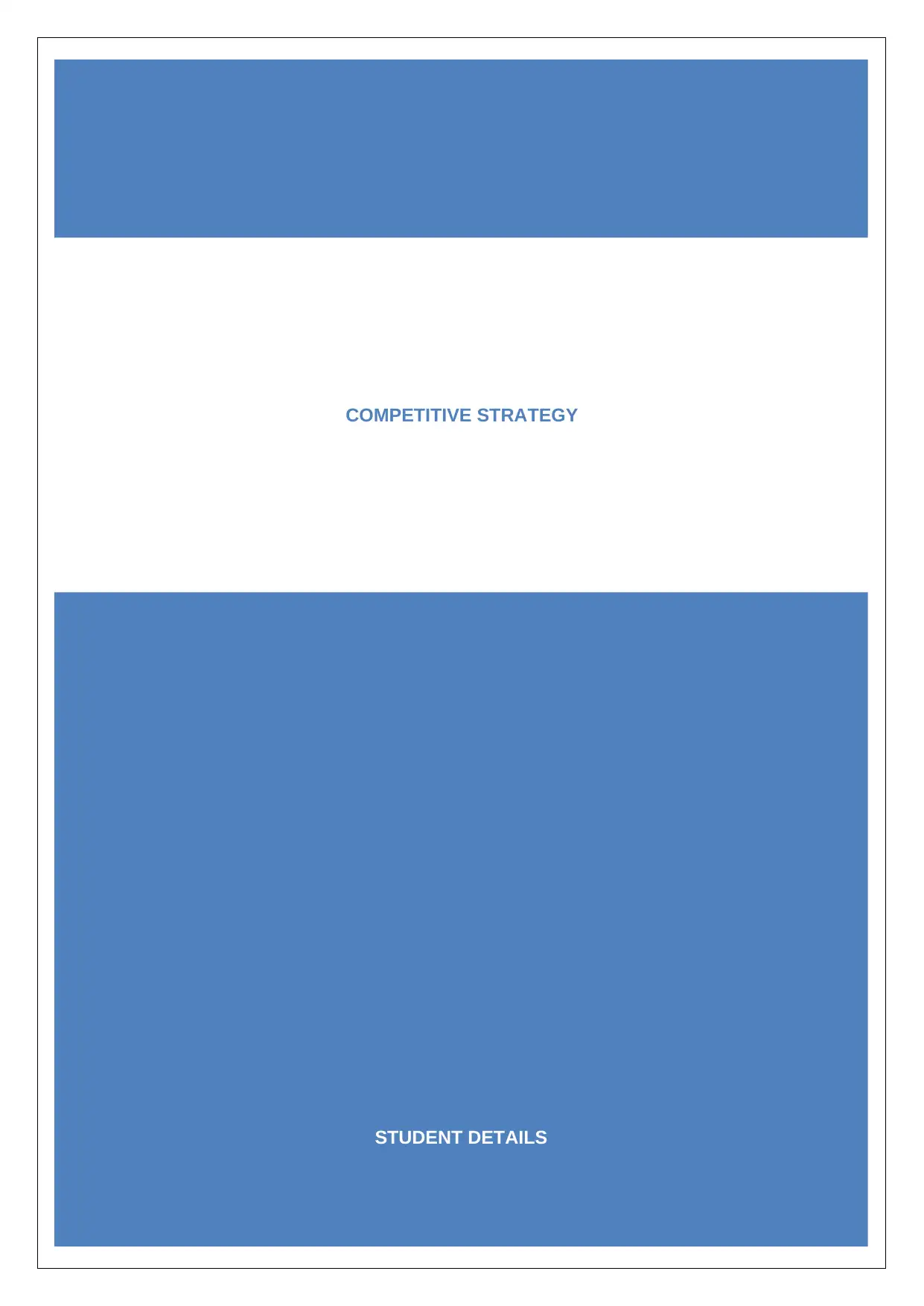
STUDENT DETAILS
COMPETITIVE STRATEGY
COMPETITIVE STRATEGY
Paraphrase This Document
Need a fresh take? Get an instant paraphrase of this document with our AI Paraphraser
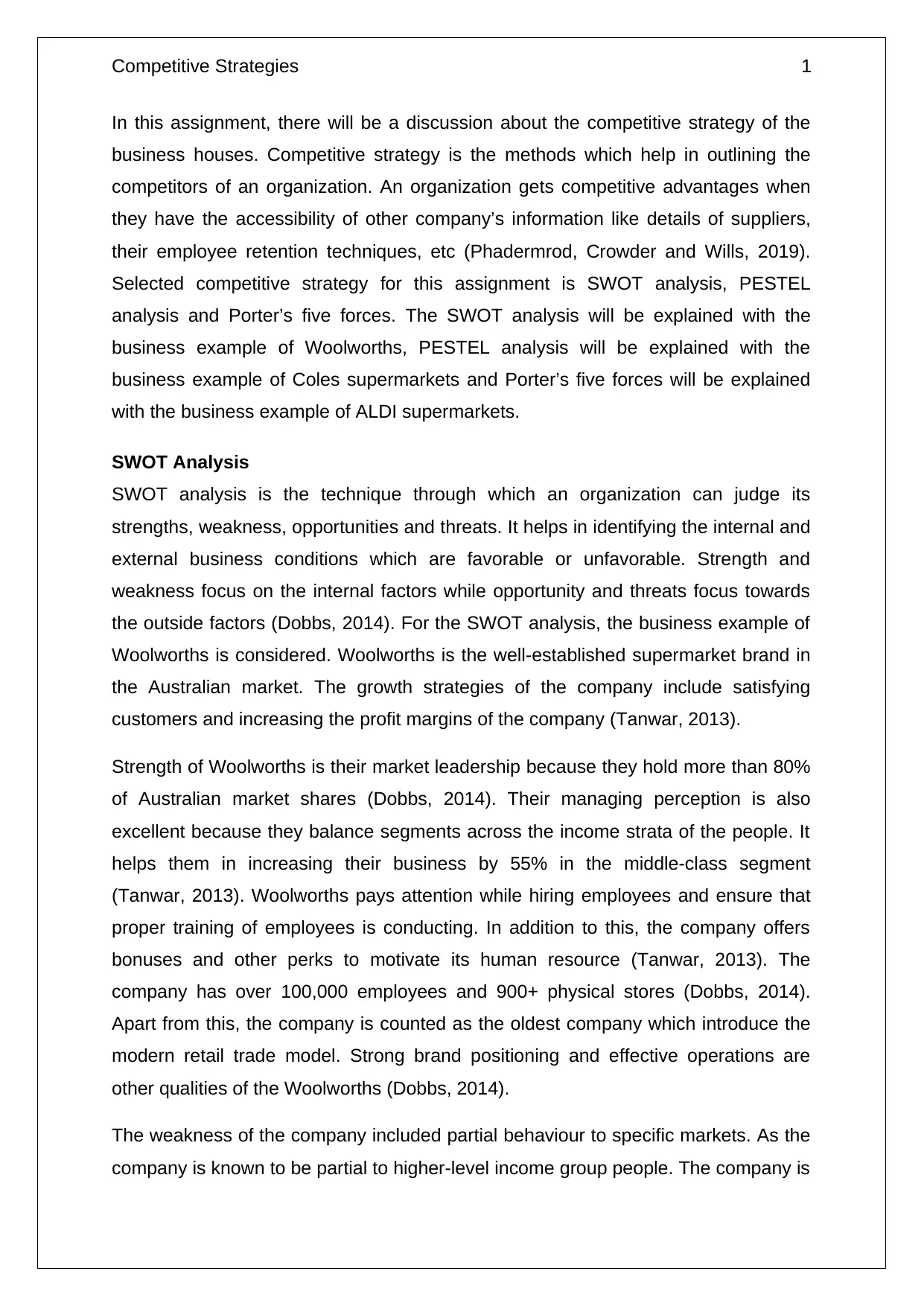
Competitive Strategies 1
In this assignment, there will be a discussion about the competitive strategy of the
business houses. Competitive strategy is the methods which help in outlining the
competitors of an organization. An organization gets competitive advantages when
they have the accessibility of other company’s information like details of suppliers,
their employee retention techniques, etc (Phadermrod, Crowder and Wills, 2019).
Selected competitive strategy for this assignment is SWOT analysis, PESTEL
analysis and Porter’s five forces. The SWOT analysis will be explained with the
business example of Woolworths, PESTEL analysis will be explained with the
business example of Coles supermarkets and Porter’s five forces will be explained
with the business example of ALDI supermarkets.
SWOT Analysis
SWOT analysis is the technique through which an organization can judge its
strengths, weakness, opportunities and threats. It helps in identifying the internal and
external business conditions which are favorable or unfavorable. Strength and
weakness focus on the internal factors while opportunity and threats focus towards
the outside factors (Dobbs, 2014). For the SWOT analysis, the business example of
Woolworths is considered. Woolworths is the well-established supermarket brand in
the Australian market. The growth strategies of the company include satisfying
customers and increasing the profit margins of the company (Tanwar, 2013).
Strength of Woolworths is their market leadership because they hold more than 80%
of Australian market shares (Dobbs, 2014). Their managing perception is also
excellent because they balance segments across the income strata of the people. It
helps them in increasing their business by 55% in the middle-class segment
(Tanwar, 2013). Woolworths pays attention while hiring employees and ensure that
proper training of employees is conducting. In addition to this, the company offers
bonuses and other perks to motivate its human resource (Tanwar, 2013). The
company has over 100,000 employees and 900+ physical stores (Dobbs, 2014).
Apart from this, the company is counted as the oldest company which introduce the
modern retail trade model. Strong brand positioning and effective operations are
other qualities of the Woolworths (Dobbs, 2014).
The weakness of the company included partial behaviour to specific markets. As the
company is known to be partial to higher-level income group people. The company is
In this assignment, there will be a discussion about the competitive strategy of the
business houses. Competitive strategy is the methods which help in outlining the
competitors of an organization. An organization gets competitive advantages when
they have the accessibility of other company’s information like details of suppliers,
their employee retention techniques, etc (Phadermrod, Crowder and Wills, 2019).
Selected competitive strategy for this assignment is SWOT analysis, PESTEL
analysis and Porter’s five forces. The SWOT analysis will be explained with the
business example of Woolworths, PESTEL analysis will be explained with the
business example of Coles supermarkets and Porter’s five forces will be explained
with the business example of ALDI supermarkets.
SWOT Analysis
SWOT analysis is the technique through which an organization can judge its
strengths, weakness, opportunities and threats. It helps in identifying the internal and
external business conditions which are favorable or unfavorable. Strength and
weakness focus on the internal factors while opportunity and threats focus towards
the outside factors (Dobbs, 2014). For the SWOT analysis, the business example of
Woolworths is considered. Woolworths is the well-established supermarket brand in
the Australian market. The growth strategies of the company include satisfying
customers and increasing the profit margins of the company (Tanwar, 2013).
Strength of Woolworths is their market leadership because they hold more than 80%
of Australian market shares (Dobbs, 2014). Their managing perception is also
excellent because they balance segments across the income strata of the people. It
helps them in increasing their business by 55% in the middle-class segment
(Tanwar, 2013). Woolworths pays attention while hiring employees and ensure that
proper training of employees is conducting. In addition to this, the company offers
bonuses and other perks to motivate its human resource (Tanwar, 2013). The
company has over 100,000 employees and 900+ physical stores (Dobbs, 2014).
Apart from this, the company is counted as the oldest company which introduce the
modern retail trade model. Strong brand positioning and effective operations are
other qualities of the Woolworths (Dobbs, 2014).
The weakness of the company included partial behaviour to specific markets. As the
company is known to be partial to higher-level income group people. The company is
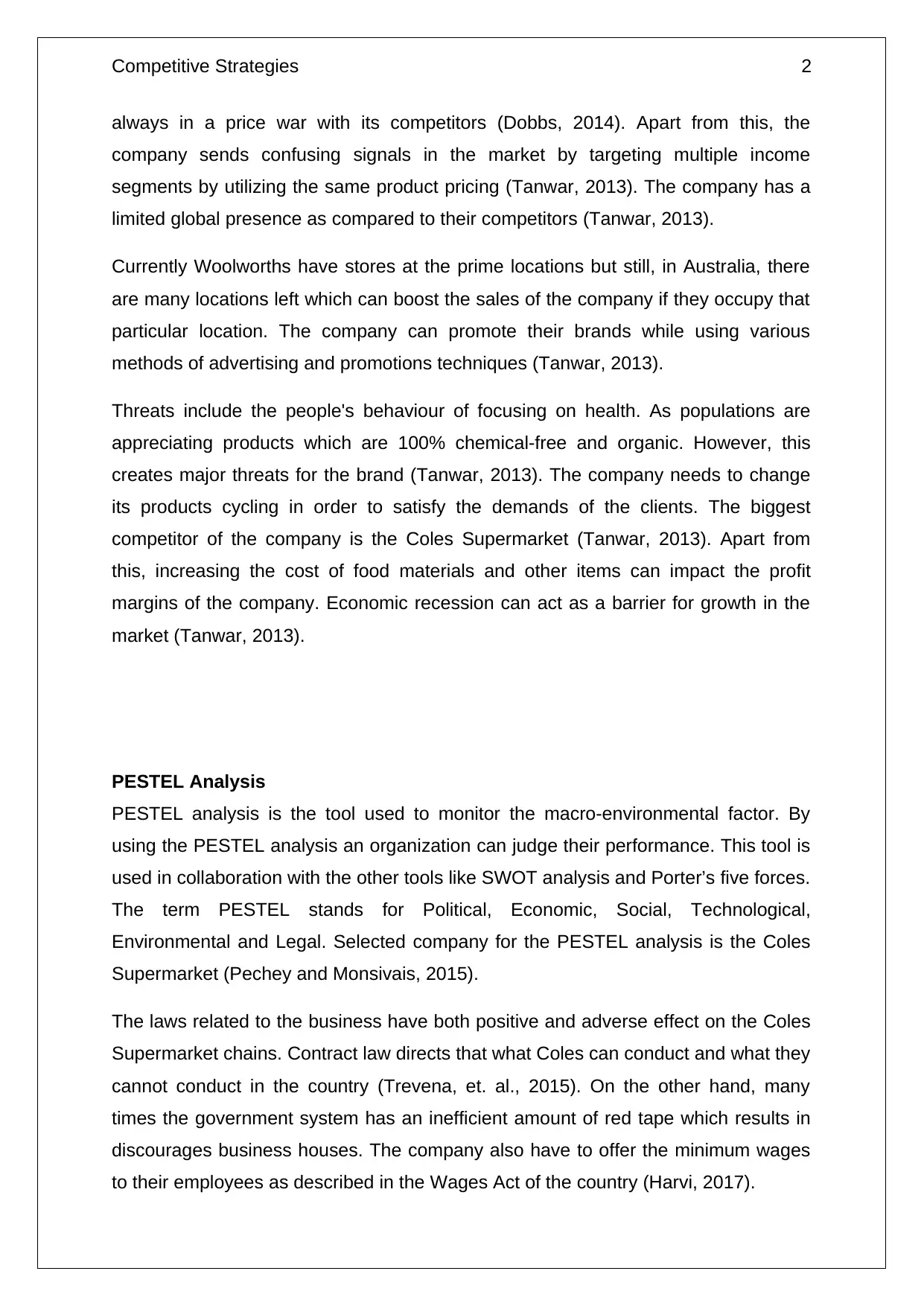
Competitive Strategies 2
always in a price war with its competitors (Dobbs, 2014). Apart from this, the
company sends confusing signals in the market by targeting multiple income
segments by utilizing the same product pricing (Tanwar, 2013). The company has a
limited global presence as compared to their competitors (Tanwar, 2013).
Currently Woolworths have stores at the prime locations but still, in Australia, there
are many locations left which can boost the sales of the company if they occupy that
particular location. The company can promote their brands while using various
methods of advertising and promotions techniques (Tanwar, 2013).
Threats include the people's behaviour of focusing on health. As populations are
appreciating products which are 100% chemical-free and organic. However, this
creates major threats for the brand (Tanwar, 2013). The company needs to change
its products cycling in order to satisfy the demands of the clients. The biggest
competitor of the company is the Coles Supermarket (Tanwar, 2013). Apart from
this, increasing the cost of food materials and other items can impact the profit
margins of the company. Economic recession can act as a barrier for growth in the
market (Tanwar, 2013).
PESTEL Analysis
PESTEL analysis is the tool used to monitor the macro-environmental factor. By
using the PESTEL analysis an organization can judge their performance. This tool is
used in collaboration with the other tools like SWOT analysis and Porter’s five forces.
The term PESTEL stands for Political, Economic, Social, Technological,
Environmental and Legal. Selected company for the PESTEL analysis is the Coles
Supermarket (Pechey and Monsivais, 2015).
The laws related to the business have both positive and adverse effect on the Coles
Supermarket chains. Contract law directs that what Coles can conduct and what they
cannot conduct in the country (Trevena, et. al., 2015). On the other hand, many
times the government system has an inefficient amount of red tape which results in
discourages business houses. The company also have to offer the minimum wages
to their employees as described in the Wages Act of the country (Harvi, 2017).
always in a price war with its competitors (Dobbs, 2014). Apart from this, the
company sends confusing signals in the market by targeting multiple income
segments by utilizing the same product pricing (Tanwar, 2013). The company has a
limited global presence as compared to their competitors (Tanwar, 2013).
Currently Woolworths have stores at the prime locations but still, in Australia, there
are many locations left which can boost the sales of the company if they occupy that
particular location. The company can promote their brands while using various
methods of advertising and promotions techniques (Tanwar, 2013).
Threats include the people's behaviour of focusing on health. As populations are
appreciating products which are 100% chemical-free and organic. However, this
creates major threats for the brand (Tanwar, 2013). The company needs to change
its products cycling in order to satisfy the demands of the clients. The biggest
competitor of the company is the Coles Supermarket (Tanwar, 2013). Apart from
this, increasing the cost of food materials and other items can impact the profit
margins of the company. Economic recession can act as a barrier for growth in the
market (Tanwar, 2013).
PESTEL Analysis
PESTEL analysis is the tool used to monitor the macro-environmental factor. By
using the PESTEL analysis an organization can judge their performance. This tool is
used in collaboration with the other tools like SWOT analysis and Porter’s five forces.
The term PESTEL stands for Political, Economic, Social, Technological,
Environmental and Legal. Selected company for the PESTEL analysis is the Coles
Supermarket (Pechey and Monsivais, 2015).
The laws related to the business have both positive and adverse effect on the Coles
Supermarket chains. Contract law directs that what Coles can conduct and what they
cannot conduct in the country (Trevena, et. al., 2015). On the other hand, many
times the government system has an inefficient amount of red tape which results in
discourages business houses. The company also have to offer the minimum wages
to their employees as described in the Wages Act of the country (Harvi, 2017).
⊘ This is a preview!⊘
Do you want full access?
Subscribe today to unlock all pages.

Trusted by 1+ million students worldwide
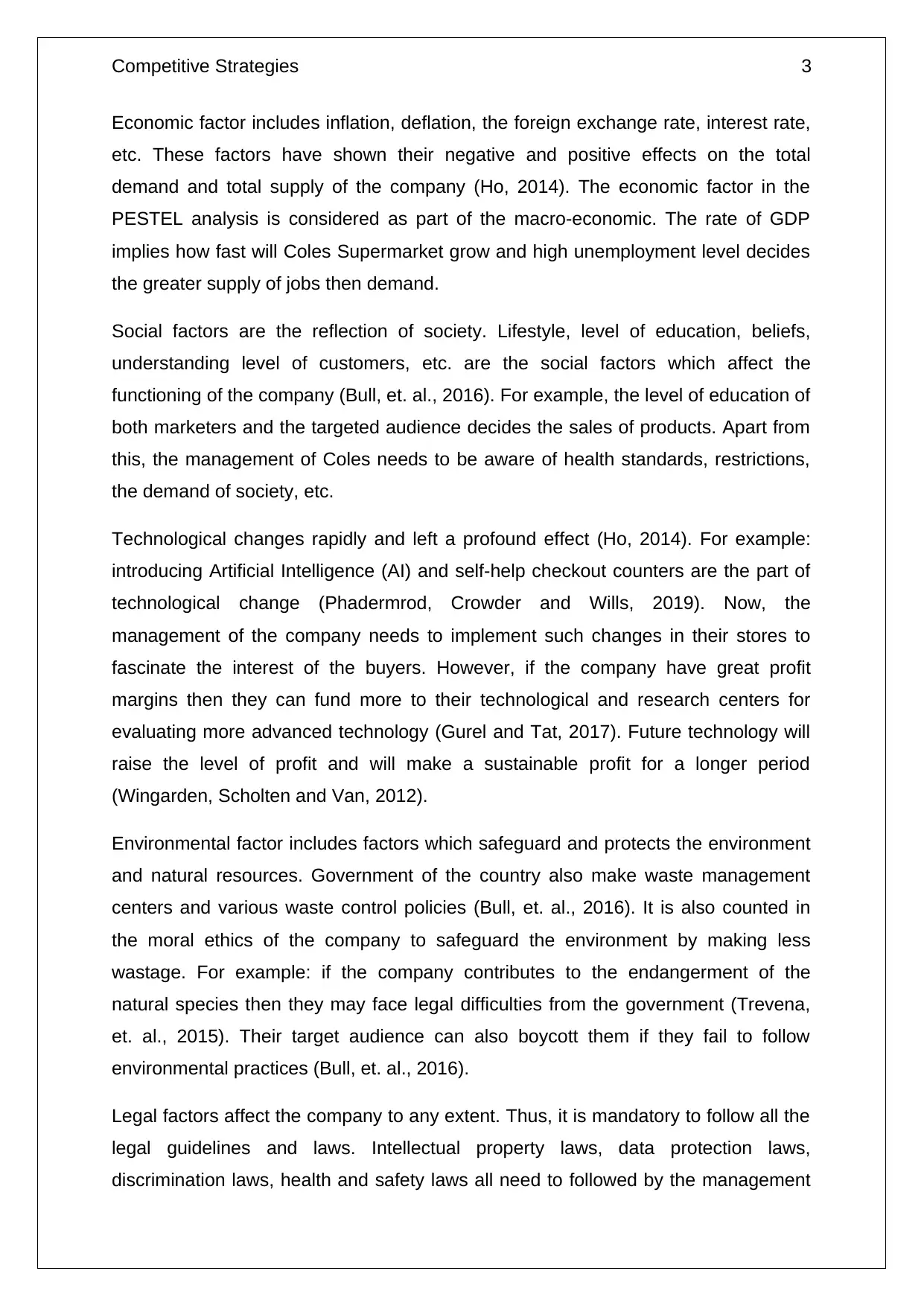
Competitive Strategies 3
Economic factor includes inflation, deflation, the foreign exchange rate, interest rate,
etc. These factors have shown their negative and positive effects on the total
demand and total supply of the company (Ho, 2014). The economic factor in the
PESTEL analysis is considered as part of the macro-economic. The rate of GDP
implies how fast will Coles Supermarket grow and high unemployment level decides
the greater supply of jobs then demand.
Social factors are the reflection of society. Lifestyle, level of education, beliefs,
understanding level of customers, etc. are the social factors which affect the
functioning of the company (Bull, et. al., 2016). For example, the level of education of
both marketers and the targeted audience decides the sales of products. Apart from
this, the management of Coles needs to be aware of health standards, restrictions,
the demand of society, etc.
Technological changes rapidly and left a profound effect (Ho, 2014). For example:
introducing Artificial Intelligence (AI) and self-help checkout counters are the part of
technological change (Phadermrod, Crowder and Wills, 2019). Now, the
management of the company needs to implement such changes in their stores to
fascinate the interest of the buyers. However, if the company have great profit
margins then they can fund more to their technological and research centers for
evaluating more advanced technology (Gurel and Tat, 2017). Future technology will
raise the level of profit and will make a sustainable profit for a longer period
(Wingarden, Scholten and Van, 2012).
Environmental factor includes factors which safeguard and protects the environment
and natural resources. Government of the country also make waste management
centers and various waste control policies (Bull, et. al., 2016). It is also counted in
the moral ethics of the company to safeguard the environment by making less
wastage. For example: if the company contributes to the endangerment of the
natural species then they may face legal difficulties from the government (Trevena,
et. al., 2015). Their target audience can also boycott them if they fail to follow
environmental practices (Bull, et. al., 2016).
Legal factors affect the company to any extent. Thus, it is mandatory to follow all the
legal guidelines and laws. Intellectual property laws, data protection laws,
discrimination laws, health and safety laws all need to followed by the management
Economic factor includes inflation, deflation, the foreign exchange rate, interest rate,
etc. These factors have shown their negative and positive effects on the total
demand and total supply of the company (Ho, 2014). The economic factor in the
PESTEL analysis is considered as part of the macro-economic. The rate of GDP
implies how fast will Coles Supermarket grow and high unemployment level decides
the greater supply of jobs then demand.
Social factors are the reflection of society. Lifestyle, level of education, beliefs,
understanding level of customers, etc. are the social factors which affect the
functioning of the company (Bull, et. al., 2016). For example, the level of education of
both marketers and the targeted audience decides the sales of products. Apart from
this, the management of Coles needs to be aware of health standards, restrictions,
the demand of society, etc.
Technological changes rapidly and left a profound effect (Ho, 2014). For example:
introducing Artificial Intelligence (AI) and self-help checkout counters are the part of
technological change (Phadermrod, Crowder and Wills, 2019). Now, the
management of the company needs to implement such changes in their stores to
fascinate the interest of the buyers. However, if the company have great profit
margins then they can fund more to their technological and research centers for
evaluating more advanced technology (Gurel and Tat, 2017). Future technology will
raise the level of profit and will make a sustainable profit for a longer period
(Wingarden, Scholten and Van, 2012).
Environmental factor includes factors which safeguard and protects the environment
and natural resources. Government of the country also make waste management
centers and various waste control policies (Bull, et. al., 2016). It is also counted in
the moral ethics of the company to safeguard the environment by making less
wastage. For example: if the company contributes to the endangerment of the
natural species then they may face legal difficulties from the government (Trevena,
et. al., 2015). Their target audience can also boycott them if they fail to follow
environmental practices (Bull, et. al., 2016).
Legal factors affect the company to any extent. Thus, it is mandatory to follow all the
legal guidelines and laws. Intellectual property laws, data protection laws,
discrimination laws, health and safety laws all need to followed by the management
Paraphrase This Document
Need a fresh take? Get an instant paraphrase of this document with our AI Paraphraser
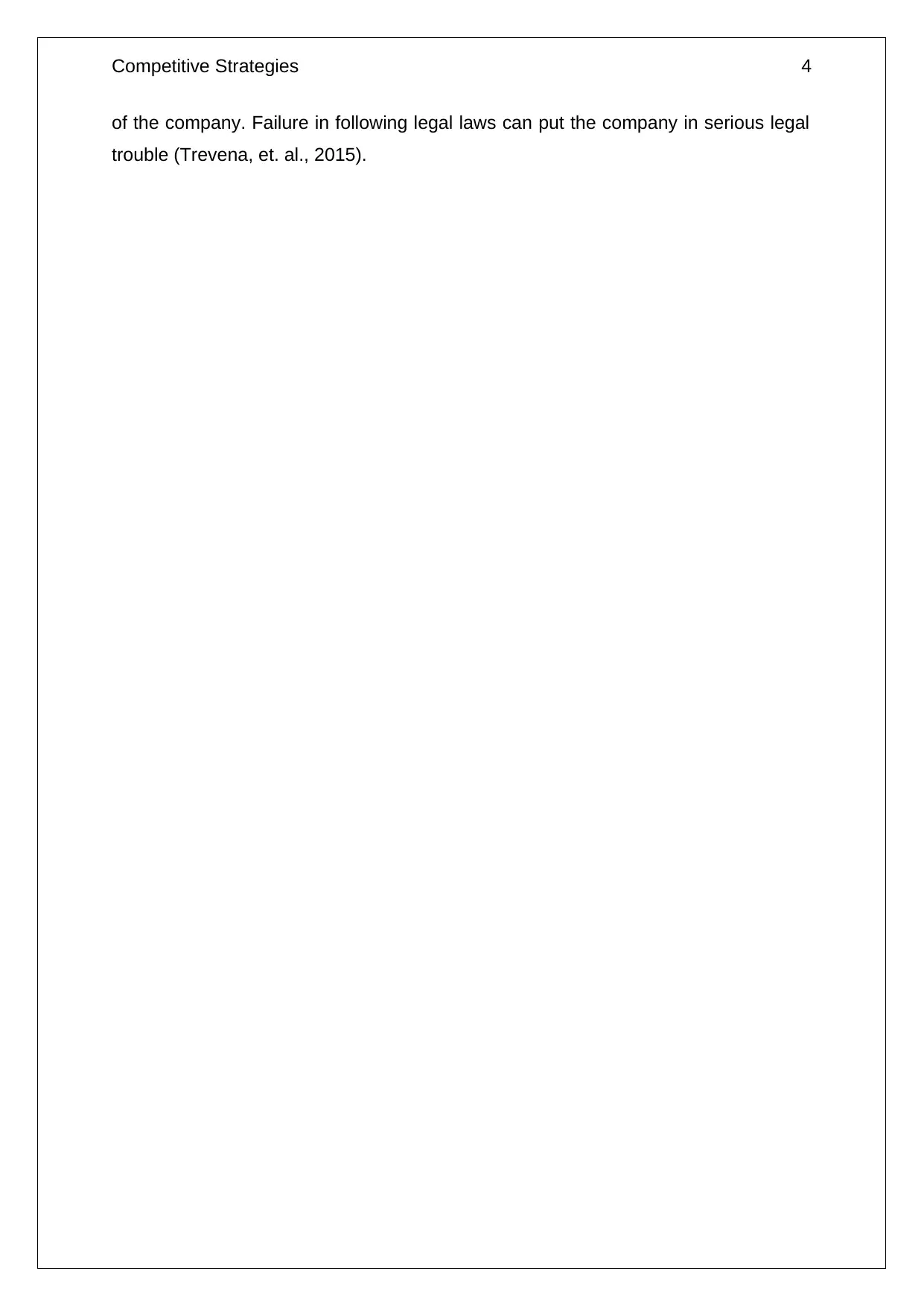
Competitive Strategies 4
of the company. Failure in following legal laws can put the company in serious legal
trouble (Trevena, et. al., 2015).
of the company. Failure in following legal laws can put the company in serious legal
trouble (Trevena, et. al., 2015).
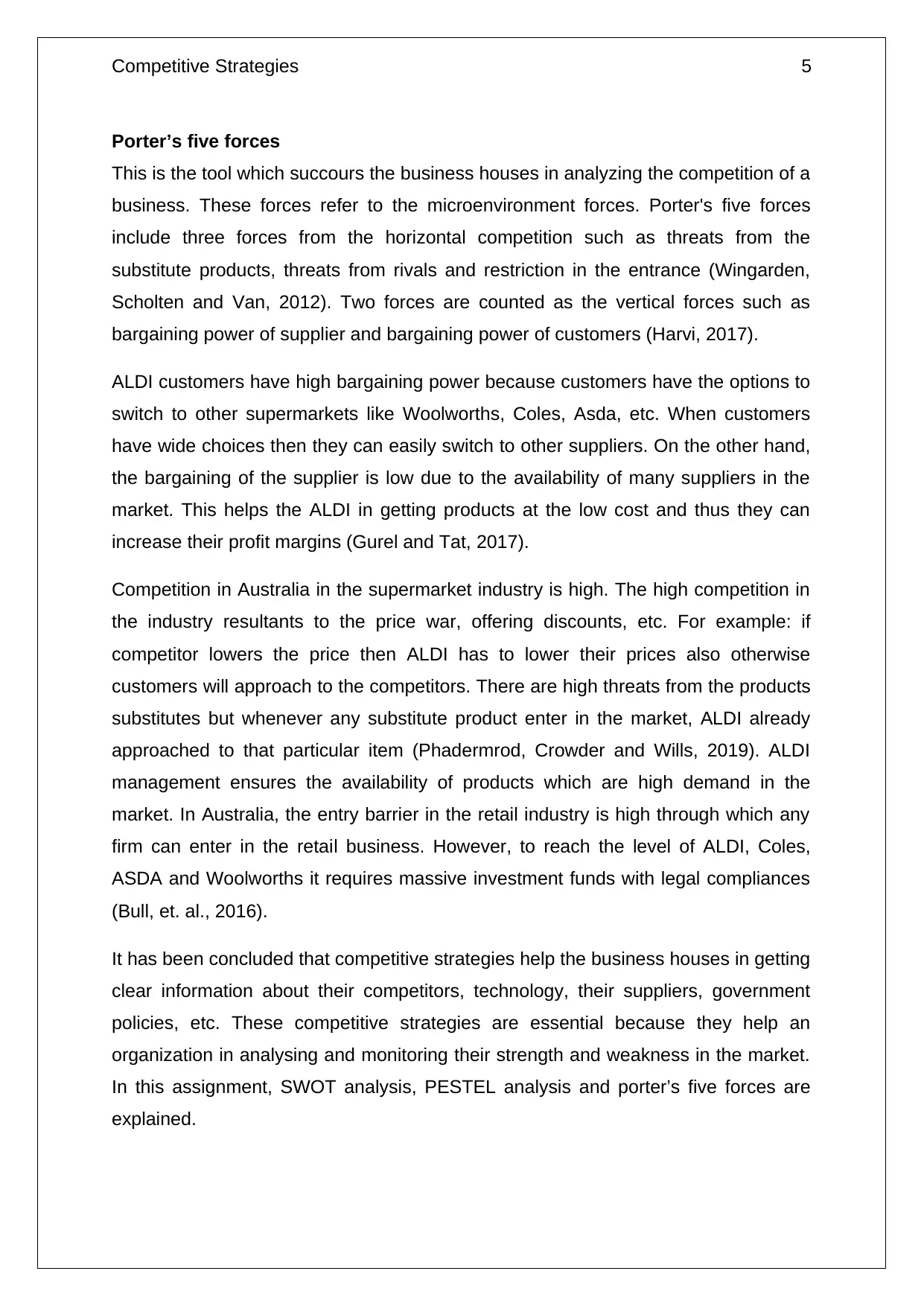
Competitive Strategies 5
Porter’s five forces
This is the tool which succours the business houses in analyzing the competition of a
business. These forces refer to the microenvironment forces. Porter's five forces
include three forces from the horizontal competition such as threats from the
substitute products, threats from rivals and restriction in the entrance (Wingarden,
Scholten and Van, 2012). Two forces are counted as the vertical forces such as
bargaining power of supplier and bargaining power of customers (Harvi, 2017).
ALDI customers have high bargaining power because customers have the options to
switch to other supermarkets like Woolworths, Coles, Asda, etc. When customers
have wide choices then they can easily switch to other suppliers. On the other hand,
the bargaining of the supplier is low due to the availability of many suppliers in the
market. This helps the ALDI in getting products at the low cost and thus they can
increase their profit margins (Gurel and Tat, 2017).
Competition in Australia in the supermarket industry is high. The high competition in
the industry resultants to the price war, offering discounts, etc. For example: if
competitor lowers the price then ALDI has to lower their prices also otherwise
customers will approach to the competitors. There are high threats from the products
substitutes but whenever any substitute product enter in the market, ALDI already
approached to that particular item (Phadermrod, Crowder and Wills, 2019). ALDI
management ensures the availability of products which are high demand in the
market. In Australia, the entry barrier in the retail industry is high through which any
firm can enter in the retail business. However, to reach the level of ALDI, Coles,
ASDA and Woolworths it requires massive investment funds with legal compliances
(Bull, et. al., 2016).
It has been concluded that competitive strategies help the business houses in getting
clear information about their competitors, technology, their suppliers, government
policies, etc. These competitive strategies are essential because they help an
organization in analysing and monitoring their strength and weakness in the market.
In this assignment, SWOT analysis, PESTEL analysis and porter’s five forces are
explained.
Porter’s five forces
This is the tool which succours the business houses in analyzing the competition of a
business. These forces refer to the microenvironment forces. Porter's five forces
include three forces from the horizontal competition such as threats from the
substitute products, threats from rivals and restriction in the entrance (Wingarden,
Scholten and Van, 2012). Two forces are counted as the vertical forces such as
bargaining power of supplier and bargaining power of customers (Harvi, 2017).
ALDI customers have high bargaining power because customers have the options to
switch to other supermarkets like Woolworths, Coles, Asda, etc. When customers
have wide choices then they can easily switch to other suppliers. On the other hand,
the bargaining of the supplier is low due to the availability of many suppliers in the
market. This helps the ALDI in getting products at the low cost and thus they can
increase their profit margins (Gurel and Tat, 2017).
Competition in Australia in the supermarket industry is high. The high competition in
the industry resultants to the price war, offering discounts, etc. For example: if
competitor lowers the price then ALDI has to lower their prices also otherwise
customers will approach to the competitors. There are high threats from the products
substitutes but whenever any substitute product enter in the market, ALDI already
approached to that particular item (Phadermrod, Crowder and Wills, 2019). ALDI
management ensures the availability of products which are high demand in the
market. In Australia, the entry barrier in the retail industry is high through which any
firm can enter in the retail business. However, to reach the level of ALDI, Coles,
ASDA and Woolworths it requires massive investment funds with legal compliances
(Bull, et. al., 2016).
It has been concluded that competitive strategies help the business houses in getting
clear information about their competitors, technology, their suppliers, government
policies, etc. These competitive strategies are essential because they help an
organization in analysing and monitoring their strength and weakness in the market.
In this assignment, SWOT analysis, PESTEL analysis and porter’s five forces are
explained.
⊘ This is a preview!⊘
Do you want full access?
Subscribe today to unlock all pages.

Trusted by 1+ million students worldwide
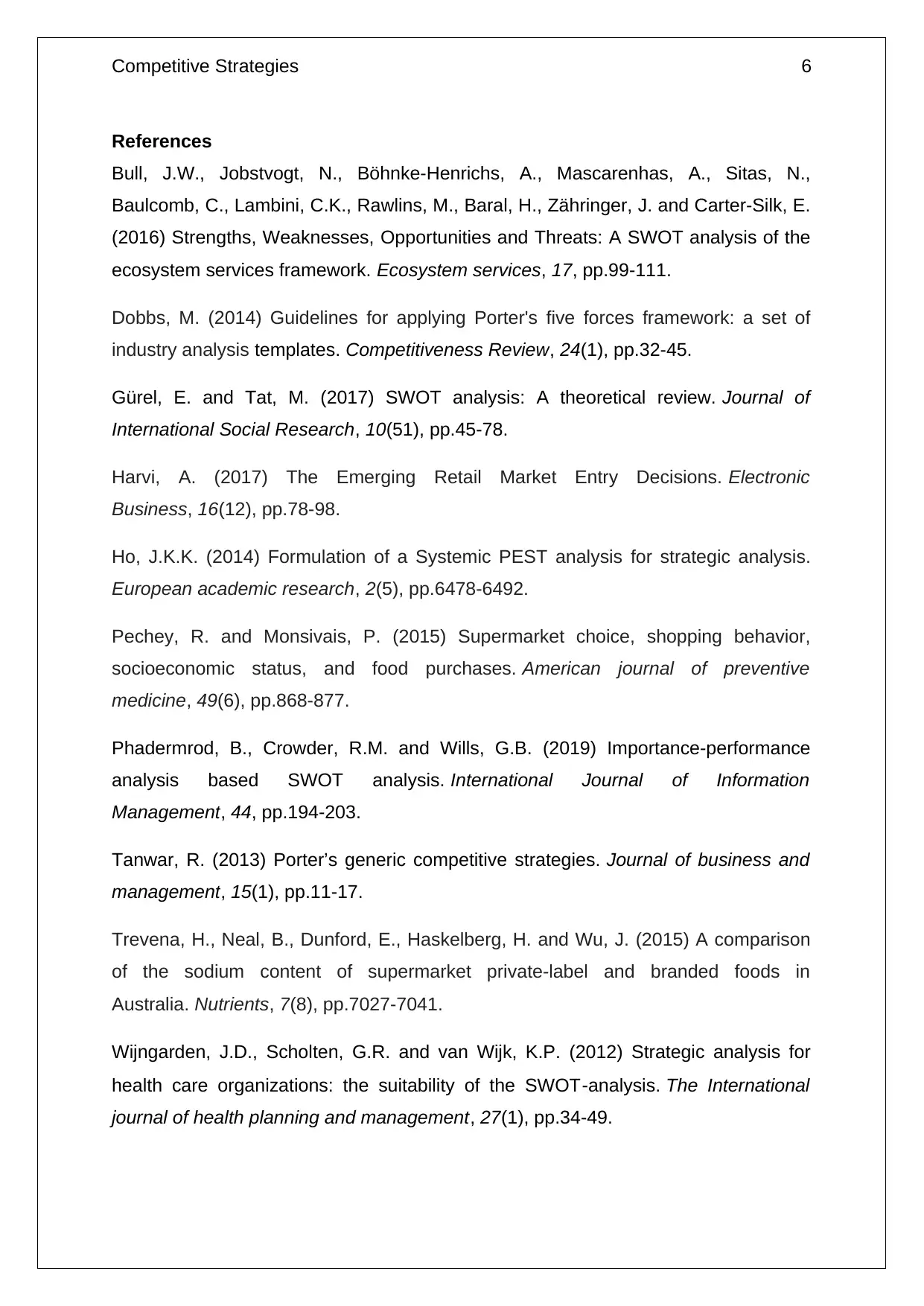
Competitive Strategies 6
References
Bull, J.W., Jobstvogt, N., Böhnke-Henrichs, A., Mascarenhas, A., Sitas, N.,
Baulcomb, C., Lambini, C.K., Rawlins, M., Baral, H., Zähringer, J. and Carter-Silk, E.
(2016) Strengths, Weaknesses, Opportunities and Threats: A SWOT analysis of the
ecosystem services framework. Ecosystem services, 17, pp.99-111.
Dobbs, M. (2014) Guidelines for applying Porter's five forces framework: a set of
industry analysis templates. Competitiveness Review, 24(1), pp.32-45.
Gürel, E. and Tat, M. (2017) SWOT analysis: A theoretical review. Journal of
International Social Research, 10(51), pp.45-78.
Harvi, A. (2017) The Emerging Retail Market Entry Decisions. Electronic
Business, 16(12), pp.78-98.
Ho, J.K.K. (2014) Formulation of a Systemic PEST analysis for strategic analysis.
European academic research, 2(5), pp.6478-6492.
Pechey, R. and Monsivais, P. (2015) Supermarket choice, shopping behavior,
socioeconomic status, and food purchases. American journal of preventive
medicine, 49(6), pp.868-877.
Phadermrod, B., Crowder, R.M. and Wills, G.B. (2019) Importance-performance
analysis based SWOT analysis. International Journal of Information
Management, 44, pp.194-203.
Tanwar, R. (2013) Porter’s generic competitive strategies. Journal of business and
management, 15(1), pp.11-17.
Trevena, H., Neal, B., Dunford, E., Haskelberg, H. and Wu, J. (2015) A comparison
of the sodium content of supermarket private-label and branded foods in
Australia. Nutrients, 7(8), pp.7027-7041.
Wijngarden, J.D., Scholten, G.R. and van Wijk, K.P. (2012) Strategic analysis for
health care organizations: the suitability of the SWOT‐analysis. The International
journal of health planning and management, 27(1), pp.34-49.
References
Bull, J.W., Jobstvogt, N., Böhnke-Henrichs, A., Mascarenhas, A., Sitas, N.,
Baulcomb, C., Lambini, C.K., Rawlins, M., Baral, H., Zähringer, J. and Carter-Silk, E.
(2016) Strengths, Weaknesses, Opportunities and Threats: A SWOT analysis of the
ecosystem services framework. Ecosystem services, 17, pp.99-111.
Dobbs, M. (2014) Guidelines for applying Porter's five forces framework: a set of
industry analysis templates. Competitiveness Review, 24(1), pp.32-45.
Gürel, E. and Tat, M. (2017) SWOT analysis: A theoretical review. Journal of
International Social Research, 10(51), pp.45-78.
Harvi, A. (2017) The Emerging Retail Market Entry Decisions. Electronic
Business, 16(12), pp.78-98.
Ho, J.K.K. (2014) Formulation of a Systemic PEST analysis for strategic analysis.
European academic research, 2(5), pp.6478-6492.
Pechey, R. and Monsivais, P. (2015) Supermarket choice, shopping behavior,
socioeconomic status, and food purchases. American journal of preventive
medicine, 49(6), pp.868-877.
Phadermrod, B., Crowder, R.M. and Wills, G.B. (2019) Importance-performance
analysis based SWOT analysis. International Journal of Information
Management, 44, pp.194-203.
Tanwar, R. (2013) Porter’s generic competitive strategies. Journal of business and
management, 15(1), pp.11-17.
Trevena, H., Neal, B., Dunford, E., Haskelberg, H. and Wu, J. (2015) A comparison
of the sodium content of supermarket private-label and branded foods in
Australia. Nutrients, 7(8), pp.7027-7041.
Wijngarden, J.D., Scholten, G.R. and van Wijk, K.P. (2012) Strategic analysis for
health care organizations: the suitability of the SWOT‐analysis. The International
journal of health planning and management, 27(1), pp.34-49.
Paraphrase This Document
Need a fresh take? Get an instant paraphrase of this document with our AI Paraphraser
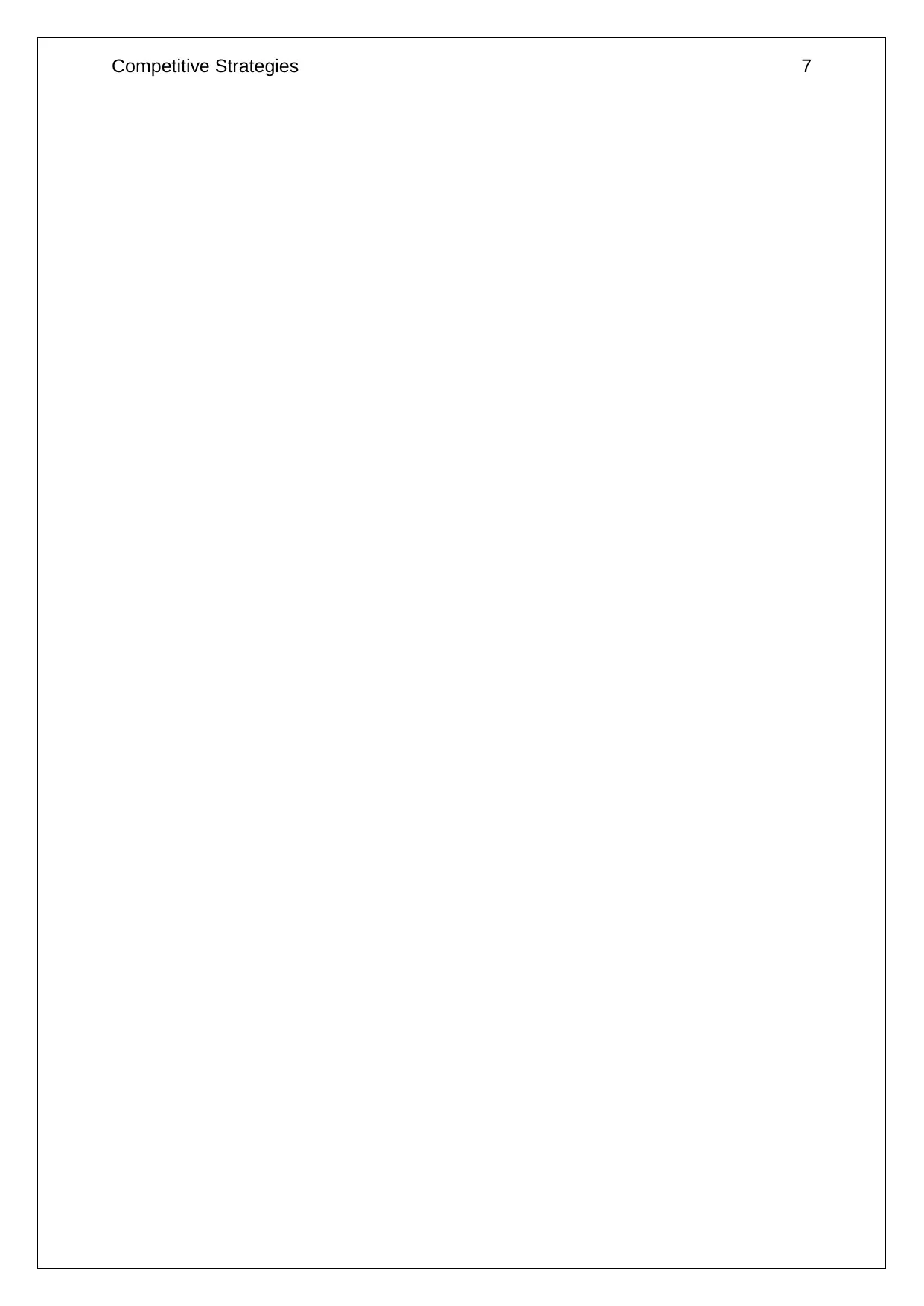
Competitive Strategies 7
1 out of 8
Related Documents
Your All-in-One AI-Powered Toolkit for Academic Success.
+13062052269
info@desklib.com
Available 24*7 on WhatsApp / Email
![[object Object]](/_next/static/media/star-bottom.7253800d.svg)
Unlock your academic potential
Copyright © 2020–2025 A2Z Services. All Rights Reserved. Developed and managed by ZUCOL.





